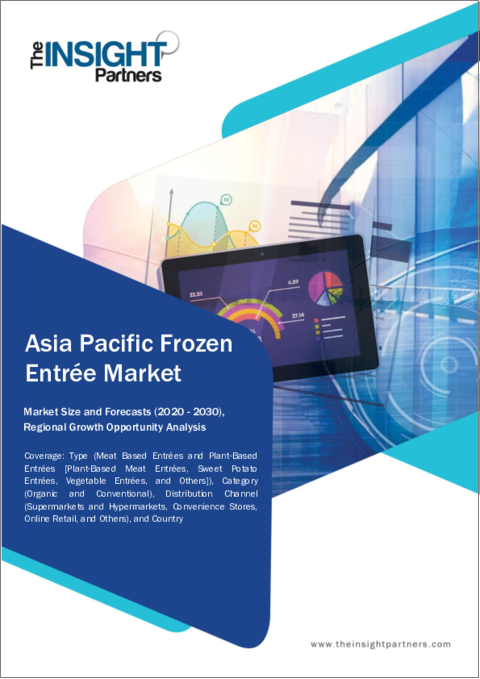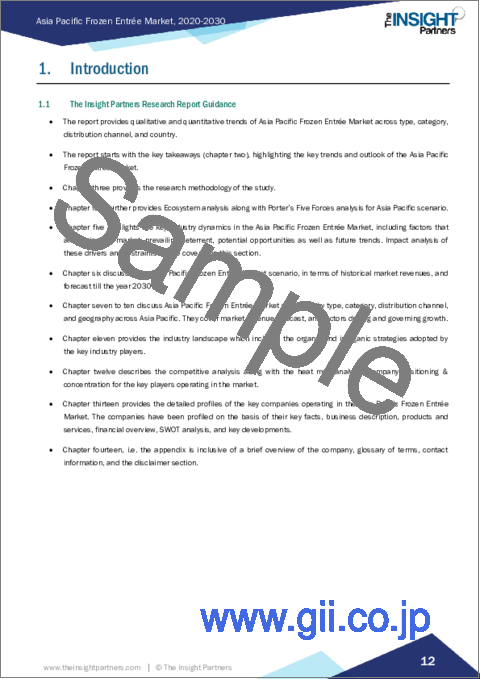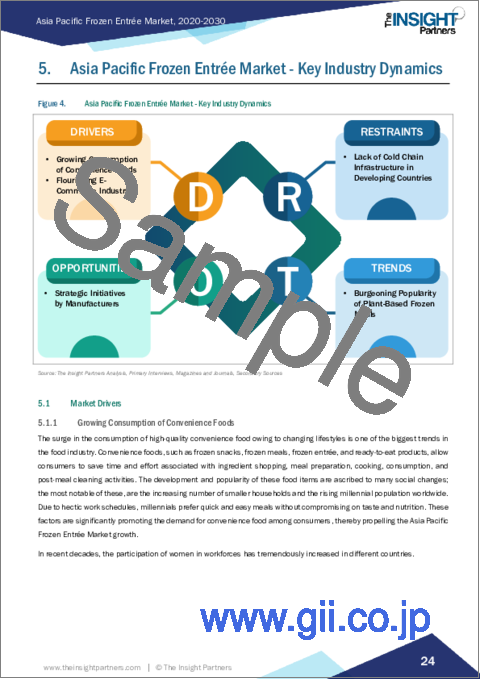|
|
市場調査レポート
商品コード
1420208
アジア太平洋の冷凍食品市場、2030年までの予測 - 地域別分析:タイプ別、カテゴリー別、流通チャネル別Asia Pacific Frozen Entree Market Forecast to 2030 - Regional Analysis- by Type, Category (Organic and Conventional), and Distribution Channel (Supermarkets & Hypermarkets, Convenience Stores, Online Retail, and Others). |
||||||
| アジア太平洋の冷凍食品市場、2030年までの予測 - 地域別分析:タイプ別、カテゴリー別、流通チャネル別 |
|
出版日: 2023年12月14日
発行: The Insight Partners
ページ情報: 英文 84 Pages
納期: 即納可能
|
- 全表示
- 概要
- 図表
- 目次
アジア太平洋の冷凍食品市場は、2022年の77億1,761万米ドルから、2030年までには122億6,102万米ドルに成長すると予測されています。2022年から2030年までのCAGRは6.0%と推定されます。
コンビニエンスフーズの消費拡大とeコマース産業の発展がアジア太平洋の冷凍食品市場を牽引
ライフスタイルの変化による高品質のコンビニエンス・フードの消費急増は、食品業界の最大の動向のひとつです。冷凍スナック、冷凍ミール、冷凍食品、調理済み製品などのコンビニエンス・フードは、消費者が食材の買い出し、食事の準備、調理、消費、食後の後片付けにかかる時間と労力を節約することを可能にします。これらの食品の開発と人気は、多くの社会的変化に起因しています。その中でも最も顕著なのは、世帯数の減少と、世界のミレニアル世代の人口増加です。多忙な仕事のスケジュールのため、ミレニアル世代は味や栄養に妥協することなく、手早く簡単な食事を好みます。こうした要因が消費者のコンビニエンス・フード需要を大きく促進し、アジア太平洋の冷凍食品市場の成長を後押ししています。
ここ数十年、女性の労働参加は各国で驚異的に増加しています。
アジア太平洋の冷凍食品市場の概要
アジア太平洋の冷凍食品市場は、中国、インド、オーストラリア、日本、韓国、その他アジア太平洋に区分されます。アジア太平洋の冷凍食品市場は、冷凍スナックのような簡便食品の消費拡大とともに急速に進展しています。消費者の可処分所得水準の上昇と中流階級の人口増加は、同地域における冷凍総菜の消費を促進する主な要因のひとつです。冷凍食品は手頃な価格で入手でき、便利で調理が簡単なため、同地域での需要は大幅に増加しています。さらに、スーパーマーケットやハイパーマーケット、コンビニエンスストア、オンライン食料品店など、近代的な小売流通プラットフォームの成長により、この地域の消費者にとって冷凍アントリーの入手しやすさと利用しやすさが広がっています。
冷凍食品メーカーは、潜在的な顧客基盤、安価な労働力、優れた製造設備を背景に、アジア太平洋全域で事業を拡大しています。Conagra Brands, IncやTyson Foods, Incといった企業は、アジア太平洋の冷凍食品市場で積極的に事業を展開しており、新製品を発表しています。2021年6月、Tyson Foods, Inc.はアジア太平洋で冷凍食品カテゴリーを立ち上げ、そのルーツを拡大しました。同社はまた、アジア太平洋における植物性製品カテゴリーの小売売上高は2020年に163億米ドルを獲得し、2025年には200億米ドルを突破すると予測していると報告しています。このように、前述したすべての要因がアジア太平洋の冷凍食品市場の成長を後押しすると予想されます。
アジア太平洋の冷凍食品市場の収益と2030年までの予測
アジア太平洋の冷凍食品市場のセグメンテーション
アジア太平洋の冷凍食品市場は、タイプ、カテゴリー、流通チャネル、国に区分されます。
タイプ別では、アジア太平洋の冷凍食品市場は肉ベースの食品と植物ベースの食品に二分されます。植物ベースの食品セグメントはさらに、サツマイモの食品、植物ベースの肉の食品、野菜の食品、その他の植物ベースの食品に分類されます。肉ベースの食品セグメントは2022年にアジア太平洋の冷凍食品市場で最大のシェアを占めました。
カテゴリー別では、アジア太平洋の冷凍食品市場は有機と従来型に区分されます。従来型セグメントは2022年にアジア太平洋の冷凍食品市場でより大きなシェアを占めました。
流通チャネル別では、アジア太平洋の冷凍食品市場はスーパーマーケットとハイパーマーケット、コンビニエンスストア、オンライン小売、その他に区分されます。スーパーマーケットとハイパーマーケット部門は、2022年のアジア太平洋の冷凍食品市場で最大のシェアを占めました。
国別に見ると、アジア太平洋の冷凍食品市場はオーストラリア、中国、インド、日本、韓国、その他アジア太平洋に区分されます。その他アジア太平洋が2022年のアジア太平洋の冷凍食品市場を独占しました。
Impossible Foods Inc、Kellogg Co、Conagra Brands Inc、Nestle SA、Del Monte Foods Inc、Mars Inc、Amy's Kitchen Incは、アジア太平洋の冷凍食品市場で事業展開している大手企業の一部です。
目次
第1章 イントロダクション
第2章 エグゼクティブサマリー
- 主要市場洞察
- 市場の魅力
第3章 調査手法
- 調査範囲
- 2次調査
- 1次調査
第4章 アジア太平洋の冷凍食品市場情勢
- ポーターのファイブフォース分析
- 供給企業の交渉力
- 買い手の交渉力
- 新規参入業者の脅威
- 競争企業間の敵対関係
- 代替品の脅威
- エコシステム分析
- 原材料サプライヤー
- メーカー
- 流通業者または供給業者
- 小売業者
第5章 アジア太平洋の冷凍食品市場:主要産業力学
- 市場促進要因
- コンビニエンス食品の消費拡大
- eコマースの発展
- 市場抑制要因
- 新興諸国におけるコールドチェーン・インフラの不足
- 市場機会
- メーカーによる戦略的取り組み
- 今後の動向
- 植物性冷凍食品の人気の高まり
- 促進要因と抑制要因の影響
第6章 冷凍食品市場:アジア太平洋市場分析
- アジア太平洋の冷凍食品市場収益、2020年~2030年
- アジア太平洋の冷凍食品市場の予測と分析
第7章 アジア太平洋の冷凍食品市場分析:タイプ
- 肉ベースの食品
- 植物ベースの食品
- 植物性肉料理
- サツマイモ料理
- サツマイモ料理
- 野菜料理
- その他の植物性料理
- その他の植物性料理
第8章 アジア太平洋の冷凍食品市場分析:カテゴリー別
- 有機
- 従来型
第9章 アジア太平洋の冷凍食品市場分析:流通チャネル別
- スーパーマーケットとハイパーマーケット
- スーパーマーケットとハイパーマーケット市場の収益と2030年までの予測
- コンビニエンスストア
- コンビニエンスストア市場の収益と2030年までの予測
- オンライン小売
- オンライン小売市場の収益と2030年までの予測
- その他
- その他の概要
- その他市場の収益と2030年までの予測
第10章 アジア太平洋の冷凍食品市場:国別分析
- オーストラリア
- 中国
- インド
- 日本
- 韓国
- その他の地域
第11章 業界情勢
- 新製品開発
- パートナーシップ
- その他の事業戦略
第12章 競合情勢
- ヒートマップ分析:主要企業別
第13章 企業プロファイル
- Impossible Foods Inc
- Kellogg Co
- Conagra Brands Inc
- Nestle SA
- Del Monte Foods Inc
- Mars Inc
- Amy's Kitchen Inc
第14章 付録
List Of Tables
- Table 1. Asia Pacific Frozen Entree Market Segmentation
- Table 2. Asia Pacific Frozen Entree Market Revenue and Forecasts to 2030 (US$ Million)
- Table 3. Australia Asia Pacific Frozen Entree Market Revenue and Forecasts to 2030 (US$ Million) - Type
- Table 4. Australia Asia Pacific Frozen Entree Market Revenue and Forecasts to 2030 (US$ Million) - Category
- Table 5. Australia Asia Pacific Frozen Entree Market Revenue and Forecasts to 2030 (US$ Million) - Distribution Channel
- Table 6. China Asia Pacific Frozen Entree Market Revenue and Forecasts to 2030 (US$ Million) - Type
- Table 7. China Asia Pacific Frozen Entree Market Revenue and Forecasts to 2030 (US$ Million) - Category
- Table 8. China Asia Pacific Frozen Entree Market Revenue and Forecasts to 2030 (US$ Million) - Distribution Channel
- Table 9. India Asia Pacific Frozen Entree Market Revenue and Forecasts to 2030 (US$ Million) - Type
- Table 10. India Asia Pacific Frozen Entree Market Revenue and Forecasts to 2030 (US$ Million) - Category
- Table 11. India Asia Pacific Frozen Entree Market Revenue and Forecasts to 2030 (US$ Million) - Distribution Channel
- Table 12. Japan Asia Pacific Frozen Entree Market Revenue and Forecasts to 2030 (US$ Million) - Type
- Table 13. Japan Asia Pacific Frozen Entree Market Revenue and Forecasts to 2030 (US$ Million) - Category
- Table 14. Japan Asia Pacific Frozen Entree Market Revenue and Forecasts to 2030 (US$ Million) - Distribution Channel
- Table 15. South Korea Asia Pacific Frozen Entree Market Revenue and Forecasts to 2030 (US$ Million) - Type
- Table 16. South Korea Asia Pacific Frozen Entree Market Revenue and Forecasts to 2030 (US$ Million) - Category
- Table 17. South Korea Asia Pacific Frozen Entree Market Revenue and Forecasts to 2030 (US$ Million) - Distribution Channel
- Table 18. Rest of Asia Pacific Frozen Entree Market Revenue and Forecasts to 2030 (US$ Million) - Type
- Table 19. Rest of Asia Pacific Frozen Entree Market Revenue and Forecasts to 2030 (US$ Million) - Category
- Table 20. Rest of Asia Pacific Frozen Entree Market Revenue and Forecasts to 2030 (US$ Million) - Distribution Channel
- Table 21. Heat Map Analysis by Key Players
List Of Figures
- Figure 1. Asia Pacific Frozen Entree Market Segmentation, By Country
- Figure 2. Porter's Five Forces Analysis
- Figure 3. Ecosystem: Asia Pacific Frozen Entree Market
- Figure 4. Asia Pacific Frozen Entree Market - Key Industry Dynamics
- Figure 5. Sign Ups for Veganuary Campaign During 2015-2021
- Figure 6. Impact Analysis of Drivers and Restraints
- Figure 7. Asia Pacific Frozen Entree Market Revenue (US$ Million), 2020 - 2030
- Figure 8. Asia Pacific Frozen Entree Market Share (%) - Type, 2022 and 2030
- Figure 9. Meat Based Entrees Market Revenue and Forecasts to 2030 (US$ Million)
- Figure 10. Plant-Based Entrees Market Revenue and Forecasts to 2030 (US$ Million)
- Figure 11. Plant-Based Meat Entrees Market Revenue and Forecasts to 2030 (US$ Million)
- Figure 12. Sweet Potato Entrees Market Revenue and Forecasts to 2030 (US$ Million)
- Figure 13. Vegetable Entrees Market Revenue and Forecasts to 2030 (US$ Million)
- Figure 14. Other Plant-Based Entrees Market Revenue and Forecasts to 2030 (US$ Million)
- Figure 15. Asia Pacific Frozen Entree Market Share (%) - Category, 2022 and 2030
- Figure 16. Organic Market Revenue and Forecasts to 2030 (US$ Million)
- Figure 17. Conventional Market Revenue and Forecasts to 2030 (US$ Million)
- Figure 18. Asia Pacific Frozen Entree Market Share (%) - Distribution Channel, 2022 and 2030
- Figure 19. Supermarkets and Hypermarkets Market Revenue and Forecasts to 2030 (US$ Million)
- Figure 20. Convenience Stores Market Revenue and Forecasts to 2030 (US$ Million)
- Figure 21. Online Retail Market Revenue and Forecasts to 2030 (US$ Million)
- Figure 22. Others Market Revenue and Forecasts to 2030 (US$ Million)
- Figure 23. Asia Pacific Frozen Entree Market by Key Country - Revenue (2022) (US$ Million)
- Figure 24. Asia Pacific Frozen Entree Market Breakdown By Key Countries, 2022 And 2030 (%)
- Figure 25. Australia Asia Pacific Frozen Entree Market Revenue and Forecasts to 2030 (US$ Million)
- Figure 26. China Asia Pacific Frozen Entree Market Revenue and Forecasts to 2030 (US$ Million)
- Figure 27. India Asia Pacific Frozen Entree Market Revenue and Forecasts to 2030 (US$ Million)
- Figure 28. Japan Asia Pacific Frozen Entree Market Revenue and Forecasts to 2030 (US$ Million)
- Figure 29. South Korea Asia Pacific Frozen Entree Market Revenue and Forecasts to 2030 (US$ Million)
- Figure 30. Rest of Asia Pacific Frozen Entree Market Revenue and Forecasts to 2030 (US$ Million)
The Asia Pacific frozen entree market is expected to grow from US$ 7,717.61 million in 2022 to US$ 12,261.02 million by 2030. It is estimated to grow at a CAGR of 6.0% from 2022 to 2030.
Growing Consumption of Convenience Foods and Flourishing E-Commerce Industry Fuel the Asia Pacific Frozen Entree Market
The surge in the consumption of high-quality convenience food owing to changing lifestyles is one of the biggest trends in the food industry. Convenience foods, such as frozen snacks, frozen meals, frozen entree, and ready-to-eat products, allow consumers to save time and effort associated with ingredient shopping, meal preparation, cooking, consumption, and post-meal cleaning activities. The development and popularity of these food items are ascribed to many social changes; the most notable of these, are the increasing number of smaller households and the rising millennial population worldwide. Due to hectic work schedules, millennials prefer quick and easy meals without compromising on taste and nutrition. These factors are significantly promoting the demand for convenience food among consumers, thereby propelling the Asia Pacific Frozen Entree Market growth.
In recent decades, the participation of women in workforces has tremendously increased in different countries.
Asia Pacific Frozen Entree Market Overview
The Asia Pacific frozen entree market is segmented into China, India, Australia, Japan, South Korea, and the Rest of Asia Pacific. The frozen entree market in Asia Pacific is rapidly advancing with the growing consumption of convenience food products such as frozen meals. The rising disposable income levels of consumers and the growth of the middle-class population are among the key factors driving the consumption of frozen entree in the region. The demand for frozen entree has significantly increased in the region as they are affordable, readily available, convenient, and easy-to-prepare meals. Furthermore, the growth of modern retail distribution platforms, including supermarkets & hypermarkets, convenience stores, and online grocery platforms, has widened the availability and accessibility of frozen entrees to consumers across the region.
Frozen entree manufacturers are expanding their operations across the Asia Pacific due to a potential customer base, cheap labor, and good manufacturing facilities. Companies such as Conagra Brands, Inc and Tyson Foods, Inc are actively operating in the Asia Pacific Frozen Entree Market in the region and are unveiling new products. In June 2021, Tyson Foods, Inc. launched the frozen entree category in Asia Pacific and expanded its roots. The firm also reported that retail sale of the plant-based products category in Asia Pacific gained US$ 16.3 billion in 2020 and is anticipated to surpass US$ 20 billion by 2025. Thus, all the aforementioned factors are expected to boost the Asia Pacific Frozen Entree Market growth.
Asia Pacific Frozen Entree Market Revenue and Forecast to 2030 (US$ Million)
Asia Pacific Frozen Entree Market Segmentation
The Asia Pacific frozen entree market is segmented into type, category, distribution channel, and country.
Based on type, the Asia Pacific frozen entree market is bifurcated into meat based entrees and plant-based entrees. The plant-based entrees segment is further categorized into sweet potato entrees, plant-based meat entrees, vegetable entrees, and other plant-based entrees. The meat-based entrees segment held a largest share of the Asia Pacific frozen entree market in 2022.
Based on category, the Asia Pacific frozen entree market is segmented into organic and conventional. The conventional segment held the larger share of the Asia Pacific frozen entree market in 2022.
Based on distribution channel, the Asia Pacific frozen entree market is segmented into supermarkets and hypermarkets, convenience stores, online retail, and others. The supermarkets and hypermarkets segment held the largest share of the Asia Pacific frozen entree market in 2022.
Based on country, the Asia Pacific frozen entree market is segmented int o Australia, China, India, Japan, South Korea, and the Rest of Asia Pacific. The Rest of Asia Pacific dominated the Asia Pacific frozen entree market in 2022.
Impossible Foods Inc, Kellogg Co, Conagra Brands Inc, Nestle SA, Del Monte Foods Inc, Mars Inc, and Amy's Kitchen Inc are some of the leading companies operating in the Asia Pacific frozen entree market.
Reasons to Buy:
- Save and reduce time carrying out entry-level research by identifying the growth, size, leading players, and segments in the Asia Pacific Frozen Entree Market.
- Highlights key business priorities in order to assist companies to realign their business strategies.
- The key findings and recommendations highlight crucial progressive industry trends in Asia Pacific Frozen Entree Market, thereby allowing players across the value chain to develop effective long-term strategies.
- Develop/modify business expansion plans by using substantial growth offering developed and emerging markets.
- Scrutinize in-depth Asia Pacific Market trends and outlook coupled with the factors driving the market, as well as those hindering it.
- Enhance the decision-making process by understanding the strategies that underpin security interest with respect to client products, segmentation, pricing and distribution.
Table Of Contents
1. Introduction
- 1.1 The Insight Partners Research Report Guidance
- 1.2 Market Segmentation
2. Executive Summary
- 2.1 Key Market Insights
- 2.2 Market Attractiveness
3. Research Methodology
- 3.1 Coverage
- 3.2 Secondary Research
- 3.3 Primary Research
4. Asia Pacific Frozen Entree Market Landscape
- 4.1 Overview
- 4.2 Porter's Five Forces Analysis
- 4.2.1 Bargaining Power of Suppliers
- 4.2.2 Bargaining Power of Buyers
- 4.2.3 Threat of New Entrants
- 4.2.4 Competitive Rivalry
- 4.2.5 Threat of Substitutes
- 4.3 Ecosystem Analysis
- 4.3.1 Raw Material Suppliers:
- 4.3.2 Manufacturers:
- 4.3.3 Distributors or Suppliers:
- 4.3.4 Retailers
5. Asia Pacific Frozen Entree Market - Key Industry Dynamics
- 5.1 Market Drivers
- 5.1.1 Growing Consumption of Convenience Foods
- 5.1.2 Flourishing E-Commerce Industry
- 5.2 Market Restraints
- 5.2.1 Lack of Cold Chain Infrastructure in Developing Countries
- 5.3 Market Opportunities
- 5.3.1 Strategic Initiatives by Manufacturers
- 5.4 Future Trends
- 5.4.1 Burgeoning Popularity of Plant-Based Frozen Meals
- 5.5 Impact of Drivers and Restraints:
6. Frozen Entree Market - Asia Pacific Market Analysis
- 6.1 Asia Pacific Frozen Entree Market Revenue (US$ Million), 2020 - 2030
- 6.2 Asia Pacific Frozen Entree Market Forecast and Analysis
7. Asia Pacific Frozen Entree Market Analysis - Type
- 7.1 Meat Based Entrees
- 7.1.1 Overview
- 7.1.2 Meat Based Entrees Market Revenue and Forecast to 2030 (US$ Million)
- 7.2 Plant-Based Entrees
- 7.2.1 Overview
- 7.2.2 Plant-Based Entrees Market Revenue and Forecast to 2030 (US$ Million)
- 7.2.3 Plant-Based Meat Entrees
- 7.2.3.1 Overview
- 7.2.3.2 Plant-Based Meat Entrees: Asia Pacific Frozen Entree Market - Revenue and Forecast to 2028 (US$ Million)
- 7.2.4 Sweet Potato Entrees
- 7.2.4.1 Overview
- 7.2.4.2 Sweet Potato Entrees: Asia Pacific Frozen Entree Market - Revenue and Forecast to 2028 (US$ Million)
- 7.2.5 Vegetable Entrees
- 7.2.5.1 Overview
- 7.2.5.2 Vegetable Entrees: Asia Pacific Frozen Entree Market - Revenue and Forecast to 2028 (US$ Million)
- 7.2.6 Other Plant-Based Entrees
- 7.2.6.1 Overview
- 7.2.6.2 Other Plant-Based Entrees: Asia Pacific Frozen Entree Market - Revenue and Forecast to 2028 (US$ Million)
8. Asia Pacific Frozen Entree Market Analysis - Category
- 8.1 Organic
- 8.1.1 Overview
- 8.1.2 Organic Market Revenue and Forecast to 2030 (US$ Million)
- 8.2 Conventional
- 8.2.1 Overview
- 8.2.2 Conventional Market Revenue and Forecast to 2030 (US$ Million)
9. Asia Pacific Frozen Entree Market Analysis - Distribution Channel
- 9.1 Supermarkets and Hypermarkets
- 9.1.1 Overview
- 9.1.2 Supermarkets and Hypermarkets Market Revenue, and Forecast to 2030 (US$ Million)
- 9.2 Convenience Stores
- 9.2.1 Overview
- 9.2.2 Convenience Stores Market Revenue, and Forecast to 2030 (US$ Million)
- 9.3 Online Retail
- 9.3.1 Overview
- 9.3.2 Online Retail Market Revenue, and Forecast to 2030 (US$ Million)
- 9.4 Others
- 9.4.1 Overview
- 9.4.2 Others Market Revenue, and Forecast to 2030 (US$ Million)
10. Asia Pacific Frozen Entree Market - Country Analysis
- 10.1 Overview
- 10.1.1 Asia Pacific Frozen Entree Market Breakdown by Country
- 10.1.1.1 Australia Asia Pacific Frozen Entree Market Revenue and Forecasts to 2030 (US$ Million)
- 10.1.1.1.1 Australia Asia Pacific Frozen Entree Market Breakdown by Type
- 10.1.1.1.2 Australia Asia Pacific Frozen Entree Market Breakdown by Category
- 10.1.1.1.3 Australia Asia Pacific Frozen Entree Market Breakdown by Distribution Channel
- 10.1.1.2 China Asia Pacific Frozen Entree Market Revenue and Forecasts to 2030 (US$ Million)
- 10.1.1.2.1 China Asia Pacific Frozen Entree Market Breakdown by Type
- 10.1.1.2.2 China Asia Pacific Frozen Entree Market Breakdown by Category
- 10.1.1.2.3 China Asia Pacific Frozen Entree Market Breakdown by Distribution Channel
- 10.1.1.3 India Asia Pacific Frozen Entree Market Revenue and Forecasts to 2030 (US$ Million)
- 10.1.1.3.1 India Asia Pacific Frozen Entree Market Breakdown by Type
- 10.1.1.3.2 India Asia Pacific Frozen Entree Market Breakdown by Category
- 10.1.1.3.3 India Asia Pacific Frozen Entree Market Breakdown by Distribution Channel
- 10.1.1.4 Japan Asia Pacific Frozen Entree Market Revenue and Forecasts to 2030 (US$ Million)
- 10.1.1.4.1 Japan Asia Pacific Frozen Entree Market Breakdown by Type
- 10.1.1.4.2 Japan Asia Pacific Frozen Entree Market Breakdown by Category
- 10.1.1.4.3 Japan Asia Pacific Frozen Entree Market Breakdown by Distribution Channel
- 10.1.1.5 South Korea Asia Pacific Frozen Entree Market Revenue and Forecasts to 2030 (US$ Million)
- 10.1.1.5.1 South Korea Asia Pacific Frozen Entree Market Breakdown by Type
- 10.1.1.5.2 South Korea Asia Pacific Frozen Entree Market Breakdown by Category
- 10.1.1.5.3 South Korea Asia Pacific Frozen Entree Market Breakdown by Distribution Channel
- 10.1.1.6 Rest of Asia Pacific Frozen Entree Market Revenue and Forecasts to 2030 (US$ Million)
- 10.1.1.6.1 Rest of Asia Pacific Frozen Entree Market Breakdown by Type
- 10.1.1.6.2 Rest of Asia Pacific Frozen Entree Market Breakdown by Category
- 10.1.1.6.3 Rest of Asia Pacific Frozen Entree Market Breakdown by Distribution Channel
- 10.1.1.1 Australia Asia Pacific Frozen Entree Market Revenue and Forecasts to 2030 (US$ Million)
- 10.1.1 Asia Pacific Frozen Entree Market Breakdown by Country
11. Industry Landscape
- 11.1 Overview
- 11.2 New Product Development
- 11.3 Partnerships
- 11.4 Other Business Strategies
12. Competitive Landscape
- 12.1 Heat Map Analysis By Key Players
13. Company Profiles
- 13.1 Impossible Foods Inc
- 13.1.1 Key Facts
- 13.1.2 Business Description
- 13.1.3 Products and Services
- 13.1.4 Financial Overview
- 13.1.5 SWOT Analysis
- 13.1.6 Key Developments
- 13.2 Kellogg Co
- 13.2.1 Key Facts
- 13.2.2 Business Description
- 13.2.3 Products and Services
- 13.2.4 Financial Overview
- 13.2.5 SWOT Analysis
- 13.2.6 Key Developments
- 13.3 Conagra Brands Inc
- 13.3.1 Key Facts
- 13.3.2 Business Description
- 13.3.3 Products and Services
- 13.3.4 Financial Overview
- 13.3.5 SWOT Analysis
- 13.3.6 Key Developments
- 13.4 Nestle SA
- 13.4.1 Key Facts
- 13.4.2 Business Description
- 13.4.3 Products and Services
- 13.4.4 Financial Overview
- 13.4.5 SWOT Analysis
- 13.4.6 Key Developments
- 13.5 Del Monte Foods Inc
- 13.5.1 Key Facts
- 13.5.2 Business Description
- 13.5.3 Products and Services
- 13.5.4 Financial Overview
- 13.5.5 SWOT Analysis
- 13.5.6 Key Developments
- 13.6 Mars Inc
- 13.6.1 Key Facts
- 13.6.2 Business Description
- 13.6.3 Products and Services
- 13.6.4 Financial Overview
- 13.6.5 SWOT Analysis
- 13.6.6 Key Developments
- 13.7 Amy's Kitchen Inc
- 13.7.1 Key Facts
- 13.7.2 Business Description
- 13.7.3 Products and Services
- 13.7.4 Financial Overview
- 13.7.5 SWOT Analysis
- 13.7.6 Key Developments




